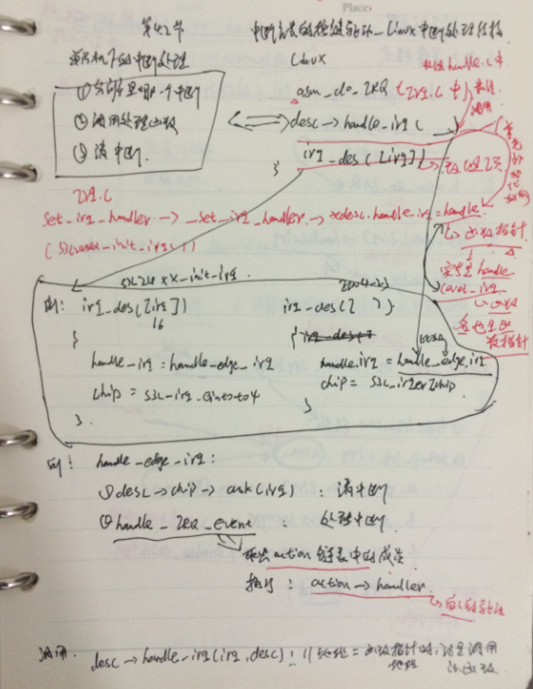这篇文章主要介绍一下Linux内核下的驱动结构与书写,以及介绍Linux下简单使用驱动的应用程序:
首先我们直接看使用驱动的简单应用程序:
#include <sys/types.h>
#include <sys/stat.h>
#include <fcntl.h>
#include <stdio.h>
#include <unistd.h>
int main(int argc, char **argv)
{
int fd;
unsigned char key_val;
fd = open("/dev/buttons", O_RDWR);
//这里就是打开一下设备驱动,具体用法可在linux下man open查找
if (fd < 0)
{
printf("can't open! ");
}
while (1)
{
read(fd, &key_val, 1);
/*从驱动对应的文件描述符中来获取到驱动提供的值,具体原理框架图见文章后面的笔 记图片*/
printf("key_val = 0x%x ", key_val);
sleep(5);
}
return 0;
}
驱动程序(这里是用来编译成模块的,后面需要再安装到内核中):
#include <linux/module.h>
#include <linux/kernel.h>
#include <linux/fs.h>
#include <linux/init.h>
#include <linux/delay.h>
#include <linux/irq.h>
#include <asm/uaccess.h>
#include <asm/irq.h>
#include <asm/io.h>
#include <asm/arch/regs-gpio.h>
#include <asm/hardware.h>
static struct class *thirddrv_class;
static struct class_device *thirddrv_class_dev;
volatile unsigned long *gpfcon;
volatile unsigned long *gpfdat;
volatile unsigned long *gpgcon;
volatile unsigned long *gpgdat;
static DECLARE_WAIT_QUEUE_HEAD(button_waitq);
/* 中断事件标志, 中断服务程序将它置1,third_drv_read将它清0 */
static volatile int ev_press = 0;
struct pin_desc{
unsigned int pin;
unsigned int key_val;
};
/* 键值: 按下时, 0x01, 0x02, 0x03, 0x04 */
/* 键值: 松开时, 0x81, 0x82, 0x83, 0x84 */
static unsigned char key_val;
struct pin_desc pins_desc[4] = {
{S3C2410_GPF0, 0x01},
{S3C2410_GPF2, 0x02},
{S3C2410_GPG3, 0x03},
{S3C2410_GPG11, 0x04},
};
/*
* 确定按键值
*/
static irqreturn_t buttons_irq(int irq, void *dev_id)
{
struct pin_desc * pindesc = (struct pin_desc *)dev_id;
unsigned int pinval;
pinval = s3c2410_gpio_getpin(pindesc->pin);
if (pinval)
{
/* 松开 */
key_val = 0x80 | pindesc->key_val;
}
else
{
/* 按下 */
key_val = pindesc->key_val;
}
ev_press = 1; /* 表示中断发生了 */
wake_up_interruptible(&button_waitq); /* 唤醒休眠的进程 */
return IRQ_RETVAL(IRQ_HANDLED);
}
static int third_drv_open(struct inode *inode, struct file *file)
{
/* 配置GPF0,2为输入引脚 */
/* 配置GPG3,11为输入引脚 */
request_irq(IRQ_EINT0, buttons_irq, IRQT_BOTHEDGE, "S2", &pins_desc[0]);
request_irq(IRQ_EINT2, buttons_irq, IRQT_BOTHEDGE, "S3", &pins_desc[1]);
request_irq(IRQ_EINT11, buttons_irq, IRQT_BOTHEDGE, "S4", &pins_desc[2]);
request_irq(IRQ_EINT19, buttons_irq, IRQT_BOTHEDGE, "S5", &pins_desc[3]);
return 0;
}
ssize_t third_drv_read(struct file *file, char __user *buf, size_t size, loff_t *ppos)
{
if (size != 1)
return -EINVAL;
/* 如果没有按键动作, 休眠 */
wait_event_interruptible(button_waitq, ev_press);
/* 如果有按键动作, 返回键值 */
copy_to_user(buf, &key_val, 1);
ev_press = 0;
return 1;
}
int third_drv_close(struct inode *inode, struct file *file)
{
free_irq(IRQ_EINT0, &pins_desc[0]);
free_irq(IRQ_EINT2, &pins_desc[1]);
free_irq(IRQ_EINT11, &pins_desc[2]);
free_irq(IRQ_EINT19, &pins_desc[3]);
return 0;
}
static struct file_operations sencod_drv_fops = {
.owner = THIS_MODULE, /* 这是一个宏,推向编译模块时自动创建的__this_module变量 */
.open = third_drv_open,
.read = third_drv_read,
.release = third_drv_close,
};
int major;
static int third_drv_init(void)
{
major = register_chrdev(0, "third_drv", &sencod_drv_fops);
thirddrv_class = class_create(THIS_MODULE, "third_drv");
thirddrv_class_dev = class_device_create(thirddrv_class, NULL, MKDEV(major, 0), NULL, "buttons"); /* /dev/buttons */
gpfcon = (volatile unsigned long *)ioremap(0x56000050, 16);
gpfdat = gpfcon + 1;
gpgcon = (volatile unsigned long *)ioremap(0x56000060, 16);
gpgdat = gpgcon + 1;
return 0;
}
static void third_drv_exit(void)
{
unregister_chrdev(major, "third_drv");
class_device_unregister(thirddrv_class_dev);
class_destroy(thirddrv_class);
iounmap(gpfcon);
iounmap(gpgcon);
return 0;
}
module_init(third_drv_init);
module_exit(third_drv_exit);
MODULE_LICENSE("GPL");
1.Linux下内核驱动结构(应用中的打开,读写操作最终会调用到驱动中的读写等):

2.以中断方式举例之中断工作原理和处理机制过程:




3.书写前面的代码以及测试:

